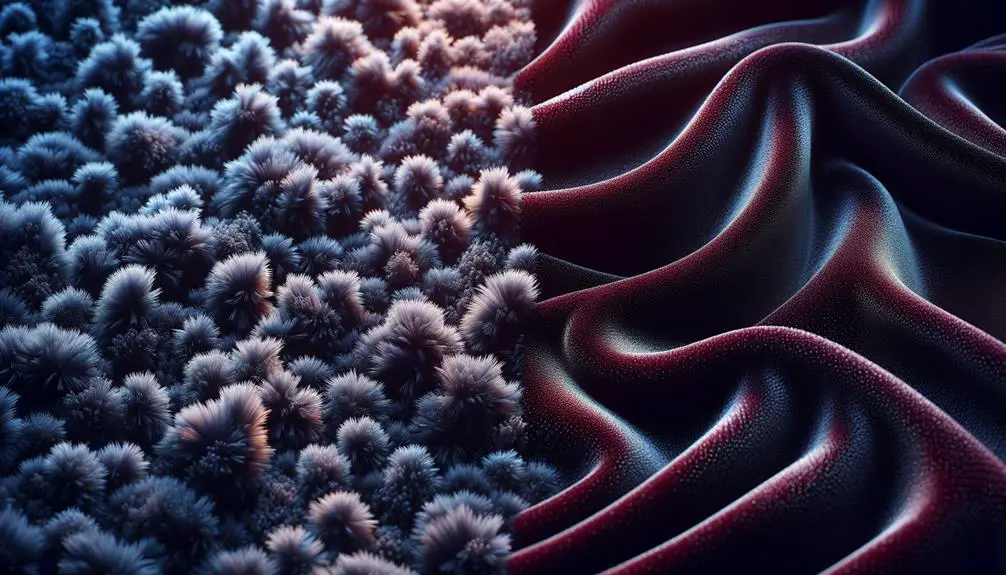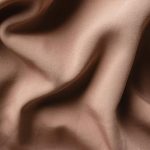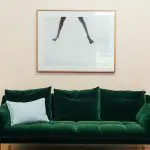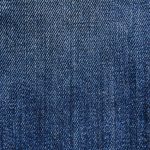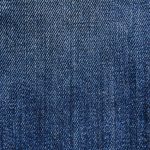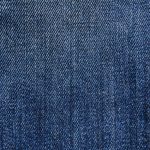I've always been intrigued by how velour can stand in for velvet, especially when you're looking for something a bit more robust for everyday wear. Like velvet, velour is lush and rich in texture, but it's crafted from cotton or synthetic fibers, making it much easier to care for. It's fascinating how velour manages to offer that same opulence while being much more durable. If you're curious about how well velour holds up compared to other velvet-like materials, or if it could be the right choice for your next project, stick around—there's more to uncover about this plush alternative.
Table of Contents
Key Takeaways
- Microfiber mimics velvet's softness and texture at a more affordable price.
- Velour offers a plush feel, made from cotton or synthetic fibers for durability.
- Suede features a velvety nap, crafted from the underside of animal skin.
- Chenille provides a soft pile similar to velvet and is highly durable.
- Faux suede is a synthetic alternative, offering easy maintenance and ethical production.
Understanding Velvet's Appeal
Velvet's allure primarily stems from its luxurious feel and elegant appearance. I've always been fascinated by how this material, once exclusive to nobility, has evolved. Diving into velvet history, it's enthralling to learn that its production began in the Far East. It was highly prized, and only the wealthy could afford it. This exclusivity added to its charm and appeal.
The method of velvet production is equally intriguing. Traditionally, it was made from silk, making it incredibly soft yet durable. The process involved intricate weaving techniques where threads were evenly distributed to create its signature dense pile. This not only contributed to its lush texture but also its deep, rich color absorption capabilities.
Understanding these aspects, it's clear why velvet is synonymous with opulence. It's not just about the material itself but the craftsmanship behind it. Each piece of velvet carries a piece of history, a reflection of the meticulous effort that went into its creation. For those of us who appreciate depth in our materials, knowing this makes velvet not just a fabric choice, but a story woven into our lives.
Microfiber: A Budget-Friendly Option
When I'm looking for a velvet-like feel without the hefty price tag, I turn to microfiber.
It's not only affordable but also combines comfort with impressive durability.
Plus, maintaining it's a breeze compared to more delicate fabrics.
Cost-Effective Comfort
Exploring cost-effective alternatives, I've found that microfiber offers the plush feel of velvet without the hefty price tag. In my quest to investigate fabric affordability and dive into comfort analysis, I've learned quite a bit about why microfiber stands out:
- Price Point: Microfiber is notably cheaper to produce and buy, making it a smart choice for budget-conscious shoppers.
- Texture and Feel: It mimics the softness and smooth texture of velvet, providing a luxurious feel without emptying your wallet.
- Versatility: This fabric adapts well across various uses, from upholstery to clothing, ensuring you get both comfort and functionality.
I'm convinced that for those who value both comfort and cost, microfiber is a top contender.
Durability and Maintenance
Besides its affordability, microfiber also impresses with its durability and ease of maintenance. It's tough, really! Unlike traditional velvet which can be a nightmare to clean, microfiber's synthetic fibers resist stains, and spills can often just be blotted out. When it comes to deeper cleaning techniques, a simple solution of soap and water does the trick without the hassle.
For minor repairs, microfiber is often easier to handle compared to other fabrics. It doesn't fray easily, and small tears can sometimes be fixed without seeing a professional. Here's a quick table that sums up why you should consider microfiber:
| Aspect | Microfiber Advantages |
|---|---|
| Maintenance | Easy to clean |
| Durability | Resists wear and tear |
| Repairs | Simple repair methods |
It's a solid, low-fuss choice!
Velour: The Plush Alternative
Velour offers a plush alternative to velvet, providing a similar luxurious feel with a distinct texture. It's fascinating how this fabric has evolved, especially when we consider its production techniques and various fashion applications. I've noticed that velour has become increasingly popular, not just for its aesthetic appeal but also for its versatility in design and use.
When you dive into the world of velour, you'll find it's made typically from cotton or synthetics, which means it's not only soft but also a bit more durable and easier to care for than traditional velvet. This makes it a favorite for both clothing designers and home decorators. Here's a quick rundown of why velour stands out:
- Production Techniques: Velour is produced by knitting, which creates loops that are then sheared to create a smooth surface. This process gives velour its characteristic plush feel.
- Fashion Applications: From tracksuits to evening wear, velour has made its mark. It offers a luxurious look without the delicacy of velvet, making it more adaptable for everyday wear.
- Ease of Maintenance: Unlike velvet, velour doesn't crush as easily, which means it holds up better in daily use and requires less meticulous care.
Suede: The Textured Substitute
Suede offers a textured feel that truly sets it apart as a luxurious yet practical alternative to velvet. If you're diving into the world of textiles, understanding suede's characteristics can really elevate your knowledge. Suede is made from the underside of animal skin, primarily from lambs, although goats, pigs, and calves are also used. This gives it a soft, napped finish which is much more durable than velvet.
Processing suede involves splitting the hide and sanding it to produce a uniform, velvety nap. This process not only enhances the texture but also the material's breathability, making it ideal for both clothing and upholstery. Unlike velvet, which is woven and often made from synthetic materials, suede remains a tribute to natural luxury with a robust edge.
Suede's maintenance is where you'll find a stark difference from velvet. It requires specific cleaning methods like brushing and occasional treatment with a suede protector to maintain its nap and prevent stains. Its ability to withstand wear makes it a go-to for items like jackets, shoes, and furniture that need to endure more than just the occasional brush with daily life.
Chenille: A Soft and Durable Choice
While exploring plush materials, it's worth noting that chenille matches the softness of velvet and surpasses it in durability. I've found that chenille isn't just a second choice but a standout on its own, particularly due to its unique manufacturing process. The yarn is twisted around a core, which results in the characteristic piles that feel delightfully soft.
Chenille's versatility is highlighted in its various uses and textures. Here's a quick rundown:
- Home Décor: Chenille is often used in throw blankets and furniture upholstery. Its durability and softness make it ideal for cozy, everyday use without wearing down too quickly.
- Clothing: From jackets to scarves, chenille provides a luxurious feel against the skin. The fabric's plush texture keeps you warm while adding a touch of elegance to any outfit.
- Accessories: It's also popular in accessories like pillows and rugs. Chenille adds a rich texture that enhances the aesthetic of any space.
I've always appreciated how chenille maintains its shape and texture even after heavy use, making it a practical choice for both fashion and home décor. The chenille textures bring a depth to items that other materials can't quite replicate, establishing its unique position among soft fabrics.
Silk Velvet: Luxurious and Sleek
I've always been captivated by the sleek and luxurious feel of silk velvet, a material that truly epitomizes elegance. When you explore the silk properties, you understand why it stands out. Silk, derived from silkworms, is celebrated for its smoothness and inherent sheen, characteristics that make the velvet it creates exceptionally plush and visually stunning.
Silk velvet is produced through unique weave techniques that combine the natural fiber with a dense pile, giving it that classic velvet texture but with a more refined, glossy finish. This type of velvet is particularly known for its lightness and the way it drapes effortlessly, making it a favorite for high-end fashion and opulent home decor.
Handling silk velvet requires a bit of know-how. It's more delicate than other types of velvet, like those made from synthetic materials, and demands careful maintenance to retain its luxurious look. Always opt for professional cleaning to preserve its elegance.
Incorporating silk velvet into your designs or wardrobe isn't just about adding a piece of fabric; it's about making a statement. This material brings a touch of sophistication that few others can match, perfect for anyone aspiring to elevate their style or interiors with a timeless texture.
Faux Suede: Vegan and Affordable
Shifting focus to another versatile material, faux suede offers an ethical and cost-effective alternative to traditional suede. Unlike its animal-derived counterpart, this fabric brings together the plush feel of suede with the benefits of modern technology. It's been a game-changer for those of us looking for sustainable alternatives that don't sacrifice style for ethics.
Here's what sets faux suede apart:
- Ethical Production: Faux suede is made from synthetic fibers, primarily polyester, which means it's completely vegan. This is a big plus for those of us who prioritize animal welfare in our fashion choices.
- Maintenance and Durability: This material is surprisingly easy to care for. It resists stains and moisture better than natural suede, making it a durable option for everyday wear. No need to worry about special cleaners; a simple brush or damp cloth usually does the trick.
- Cost-Effectiveness: Being synthetic, faux suede is also more affordable than real suede. This makes it accessible for a wider audience, allowing more people to enjoy its luxe appearance without breaking the bank.
Given these faux characteristics, it's clear why faux suede has become such a popular choice among ethical and budget-conscious buyers. It's truly a demonstration of how innovative materials can redefine our approach to fashion and sustainability.
Corduroy: The Ridged Contender
Now, let's talk about corduroy, a fabric that's as unique as it's timeless.
We'll explore how its distinctive texture is created, trace back through its history, and I'll share some practical tips on how to keep it looking great.
Understanding these aspects helps us appreciate why corduroy remains a beloved choice for both fashion and function.
Corduroy Texture Explained
Corduroy's distinctive ridges, known as wales, give it a unique texture that sets it apart from other materials like velvet. In exploring its ridged origins, it's clear that the structure of corduroy isn't just for aesthetics but also for functionality. The weave variations in corduroy allow for different textures and durability levels, making it incredibly versatile.
Here's what you need to know:
- Wale Count: The number of wales per inch varies, affecting the texture; fewer wales mean a chunkier feel.
- Weave Type: Corduroy can feature plain, twill, or even sateen weaves, each offering a different hand feel and visual aesthetic.
- Material Blend: While traditionally cotton, modern corduroys incorporate synthetic fibers, enhancing stretch and comfort.
History of Corduroy
Let's explore the storied past of corduroy, a fabric that has woven its way through centuries of fashion and utility. Tracing corduroy origins takes us back to ancient Egypt where early forms of this ridged fabric were first developed. It wasn't until the industrial revolution in Europe that corduroy was refined and popularized.
Here's a quick look at its timeline:
| Era | Development |
|---|---|
| 200 AD | Early weaving techniques in Egypt |
| 18th Century | Gained popularity in Europe |
| 20th Century | Became a fashion staple |
Each phase of history refined the weaving techniques, making corduroy more durable and stylish. Its unique texture has stood the test of time, continually adapting yet remaining a classic choice in wardrobes around the world.
Corduroy Care Tips
Maintaining your corduroy isn't complicated; just follow a few simple care tips to keep it looking its best. Here's how I tackle it:
- Washing Technique: Always turn your corduroy garments inside out before washing. Use cold water and a gentle cycle to prevent the ridges from flattening and to minimize color variations.
- Drying Method: Avoid the dryer. Instead, I lay my corduroy flat or hang it up to air dry. This prevents shrinkage and helps maintain the fabric's texture.
- Stain Removal: For stains, I dab gently with a mild detergent solution rather than rubbing. This method is effective and helps preserve the fabric's distinctive ridges and prevents color fading.
Fleece: Cozy and Warm
Fleece, known for its incredible warmth, offers a cozy comfort that's hard to match. This material, initially crafted to mimic the feel of wool while being lighter and less expensive, has origins deeply rooted in performance gear. Developed in the 1970s, fleece revolutionized the textile industry with its remarkable properties. I've come to appreciate its benefits: it's incredibly soft, seriously warm, and water-resistant. Plus, it's a vegan alternative to wool, which is a huge plus for those of us looking to make more ethical clothing choices.
I'm particularly fond of how fleece manages to provide such effective insulation while remaining breathable. This makes it an ideal choice for active wear where you need to stay warm without overheating. Its ability to wick moisture away from the body yet retain heat even when wet is a game-changer for any outdoor enthusiast like myself.
Moreover, caring for fleece is straightforward. It resists pilling and maintains its shape after multiple washes, which isn't always the case with other warm materials. For anyone seeking a cozy, durable, and easy-to-maintain fabric, fleece is definitely worth considering. It's become a staple in my winter wardrobe, and I can't imagine cold days without it.
Knit Fabrics: Stretchy and Comfortable
Knit fabrics offer a unique combination of stretch and comfort that's perfect for everyday wear. Unlike the static nature of woven materials, knit fabrics are designed with flexibility in mind, adapting to your body's movements without sacrificing style. This makes them ideal for a range of activities, from a relaxed day at home to a busy afternoon running errands.
To really understand why knit fabrics are a go-to choice for those who prioritize comfort and practicality, let's break down their key characteristics:
- Fabric Elasticity: Knit fabrics excel in elasticity due to their looped construction, allowing them to stretch more than woven fabrics. This elasticity not only enhances comfort but also makes these fabrics forgiving and adaptable to various body shapes.
- Comfort Assessment: When evaluating comfort, knit fabrics rank high due to their soft texture and breathability. They maintain a gentle touch against the skin, reducing irritation and making them suitable for prolonged wear.
- Durability and Maintenance: Despite their softness and stretch, knit fabrics are surprisingly durable. They resist wrinkling and often require less care than other types of fabrics, making them a practical choice for daily wear.
Frequently Asked Questions
How Can I Identify Genuine Velvet Versus Its Substitutes?
To identify genuine velvet, I'd feel the fabric's texture and possibly perform a fabric burn test. Real velvet has a distinct, dense pile and burns differently than synthetic substitutes.
Are Velvet-Like Materials Safe for Pet-Friendly Homes?
I've found that velvet-like materials can be safe for homes with pets, especially if they're hypoallergenic and easy to clean. It's important to check for pet allergies and adopt proper cleaning methods.
What Historical Era Popularized Velvet?
The Renaissance era really kicked off velvet's popularity. It's when its luxurious texture and sheen caught the eyes of nobility. Velvet origins can be traced even further back, though, deep into historical textiles.
Can Velvet Alternatives Be Used in Outdoor Furniture?
Yes, velvet alternatives like microfiber or performance velvet can be used for outdoor furniture. They offer great weather resistance and maintenance ease, making them perfect for withstanding the elements and frequent use.
Which Velvet-Like Materials Are Hypoallergenic?
I've found that microfiber's a great hypoallergenic choice; it mimics velvet's texture without triggering fabric allergies. It's soft, durable, and doesn't hold onto allergens, making it ideal for sensitive users.
- What Is Gore-Tex Active? A Guide to the Lightweight Fabric - July 1, 2025
- What Is Gore-Tex Active? A Guide to the Lightweight Fabric - July 1, 2025
- What Is Gore-Tex Active? A Guide to the Lightweight Fabric - July 1, 2025

